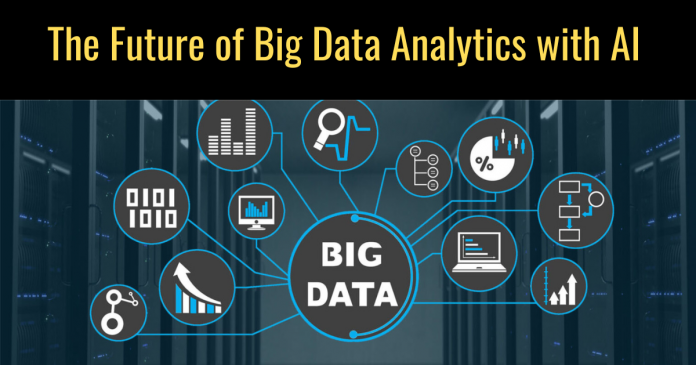Artificial Intelligence (AI) and Machine Learning (ML) are driving advances in the use of information through the use of Big Data Analytics (BDA) systems in an environment that is current and excessive in terms of volumetric data. AI and ML will first have an influence because it reads through data in real-time, recognizes complex patterns, and provides predictive and prescriptive suggestions that extend and augment the aforementioned traditional analytics functions.
In the progress from reactive or descriptive analysis to proactive actions, the transition will allow governments, companies and educational institutions to readily identify strategic opportunities, advance their process optimizations and automation, and enhance their speed of innovation. Due to the growing availability and variability of big data analytics software market that is AI-ready will be critical for organizations aiming to be proactive learners to achieve their viable knowledge and relevance in a fast-evolving and complex digital ecosystem.
The Evolution of Big Data Analytics
Big data analytics software has developed into an effective platform for proactive decision-making, moving beyond its initial use as a tool for storing and summarizing historical data. Big data analytics first concentrated on descriptive analytics, using reports and visualizations to assist enterprises in understanding historical occurrences. The automation of pattern recognition, predictive forecasting, and prescriptive recommendations have fundamentally altered big data analysis. These elements of artificial intelligence and machine learning empower analytics to develop a forward-looking decision-making tool that has strategic value for an enterprise by enabling organizations to not only react to past patterns but also predict future outcomes and prescriptively manage their plan.
AI and ML: Catalysts for Advanced Analytics
Artificial intelligence consists of systems that can perform tasks requiring human intelligence like reasoning, learning, and decision making. Machine learning is a specially designed sub-category of AI thinking, focused on developing algorithms that learn based on available data to improve its performance over time and without strict programming. When AI and ML are incorporated into analytics software with big data, it provides a number of transformational functionalities:
- Advanced Pattern Recognition
AI can employ ML algorithms in similar manners to identify correlations and anomalies authenticating millions of data points which might otherwise be considered unrecognizable by humans.
- Automate Decision-Making
To address such issues as fraud, AI can be used to gather analytics and recommend solutions. AI computers can make decisions on the spot without any human interference, thus the mentioned procedures become more efficient.
- Predictive Analytics
AI models may predict future trends, hazards, and opportunities based on previous data. And ML models may estimate future events including market movements, consumer behavior, and operational constraints by analyzing previous data.
- Natural Language Processing (NLP)
Artificial Intelligence makes it easier for people who are not technical to work with the data by supporting analysts to ask and handle the data in the common language. An AI-based natural language processing tools permit people to interact with databases using the natural language. Thus, access to insights is standardized and the reliance on experts is minimized.
Industry Impacts:
- Healthcare
By means of AI analytics, patient care is revolutionized through the techniques of early illness identification, individualized therapies, and efficient allocation of resources. Machine learning evaluates genetic data, imaging, and medical records to help forecast the course of aggregate diseases, detect health concerns, and enhance diagnostics. Thus, accuracy is increased, which maximizes the therapeutic interventions directed at a patient for enhanced outcomes.
- Financial Services
From improving investment optimization, credit risk assessment, and fraud detection to the execution of operations, artificially intelligent programs are being used widely nowadays in financial organizations. On a broad spectrum, algorithmic trading techniques are introduced by machine learning. Questionable transactions are targeted, whiles risk is gauged in almost real time. Consumer analytics based on AI manufacture an optimized client experience of efficiency and security where financial products and services are made to fit each client.
- Manufacturing and Logistics
Making the industrial processes efficient with AI-enabled analytics are supply chain-based optimization, quality control, and predictive maintenance. Machine learning predicts a breakdown in equipment, thereby lengthening asset life and reducing downtime. AI controls supply chain demand swings and makes automated defect detection possible, increasing productivity, cutting expenses, and guaranteeing constant product quality throughout production processes.
- Retail and E-Commerce
With AI-driven predictive analytics, retailers improve inventory, design consumer experiences, and determine pricing. Through the examination of consumer behavior, AI predicts demand, manages dynamic pricing, and offers personalized suggestions. This results in the increase of engagement, revenue, and operational efficiency across the retail spectrum.
- Government and Public Sector
Predictive analytics powered by AI make a significant positive impact on the public safety, traffic management, and the effective use of resources, which are the key areas for good urban governance. Predictive modeling is expanding the effectiveness of social programs besides that is planning the routing of resources with maximum social returns, while the use of pattern recognition facilitates the simple identification of fraud and provides tax compliance.
Important Trends Shaping the Future of AI-Driven Big Data Analytics:
- Real-Time Analytics
Batch processing was frequently used in traditional analytics, with insights produced following data gathering. Analytics software is shifting toward streaming analytics systems in response to the need for real-time decision-making. These days, AI systems are able to rapidly initiate automatic activities, examine real-time data streams, and identify abnormalities.
- Augmented Analytics
Artificial intelligence is used in augmented analytics to automate the creation of explanations, insights, and data preparation. It enables businesses to make choices more quickly and accurately by minimizing manual intervention. This opens up the data analytics field to more people by providing them with the necessary insights that are easily understandable and accessible and that do not require any technical skills. When used along with traditional analytics tools, AI will facilitate data visualization, storytelling, and decision-making that will enhance the comprehension of the findings by the technical staff.
- Edge Computing Integration
Using local data, the AI and ML algorithms integrated into edge devices can not only minimize latency, the amount of bandwidth consumed and the dependence on the cloud infrastructure but also can improve the overall performance of the system. In the case of autonomous vehicles and smart cities, the real-time analytics are facilitated by the decentration of data, thus, the time lag and the volume of the data transmitted are significantly reduced.
- Ethical AI and Responsible Analytics
Ethics are becoming more and more important as AI becomes a part of analytics. Businesses are focused on AI model openness, explainability, and preventing bias. Analytical software development is currently being shaped by regulation tracks like GDPR, which emphasize data protection, security, and ethical AI uses.
Big Data Analytics Software Market:
Big data analytics software market all over the world has been energized with the major technological changes that have taken place in machine learning, artificial intelligence, and cloud technologies. This trend is backed by the increasing reliance on data-driven decision-making, which is spreading in different areas, such as manufacturing, retail, healthcare, and finance. Apart from the need for real-time analytics, the industry has also been witnessing these trends such as the growth of unstructured data, the implementation of AI and ML functions in analytics platforms, which have been leading to the markets expansion.
Future Outlook
According to Pristine Market Insights, the future of big data analytics software will be driven by advanced AI and machine learning integration, automation, and wider accessibility. The most recent trends are to give the users AI powered self-service analytics tools, using hybrid AI models for better decision making, applying quantum computing for complex calculations, leading analytics to focus on sustainability, and creating sector-specific AI solutions that deliver specialized insights.
The use and management of data by businesses are going through a major change, with the implementation of AI and machine learning in big data analytics being the primary driver. AI driven systems are the source of faster, smarter, and more strategic decision-making, as they provide predictive and prescriptive insights. On top of the issues of data quality and ethics, these tools are at the same time making it possible to have innovations, increase efficiency, and have competitive advantages. The result is that data-driven strategies are becoming strategic, transformational, and anticipatory.


